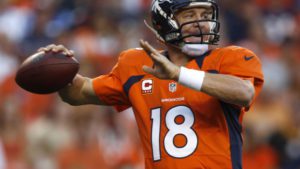 Anyone following the NFL—and many who don’t—know that Peyton Manning is one of the best quarterbacks in history. Last year he set single-season records for touchdowns and passing yards, and of course this year his team is playing in the Superbowl against Seattle.
Anyone following the NFL—and many who don’t—know that Peyton Manning is one of the best quarterbacks in history. Last year he set single-season records for touchdowns and passing yards, and of course this year his team is playing in the Superbowl against Seattle.
I am a Peyton Manning fan. But the reason that I am writing about him is because of his recovery—a resurrection, really—from a neck condition that resulted in four surgeries and would have ended the career of most professional athletes.
So, what did Peyton do to have one of his best years yet, at age 37, following such physical trauma? I don’t know the details of his rehabilitation, but there are some pieces that we do know.
- Peyton sought help from the experts and his athlete friends. He found out what he could about his condition, though he recognized that every individual heals differently.
- He rested. For almost three months after his fourth surgery (a second vertebral fusion) he did not pick up a football.
- He started slow and built himself up patiently. He was forced to listen to his body, and with the guidance of his trainers he started with minimal movement and minimal weight, throwing darts instead of footballs, lifting only five-pound weights, and sitting in front of a mirror practicing his throwing action.
- He changed the way he plays. His right arm is still weaker than his left, so he had to relearn and alter his game to match his new body.
- He put it all into perspective. His older brother Cooper was a promising wide-receiver who had to quit football at a young age because of spinal stenosis (a narrowing of the spaces within the spine, putting pressure on the spinal cord). At age 16 Peyton was told by his doctor that his neck curvature was a potential problem, but he was fortunate to be able to play without major injury for 20 years, and he didn’t take his talent for granted. He also became a proud father of twins and said that though it was hard to be fighting for the return of his physical gift, the gain of having his kids was an equalizer. “I would take that trade any day of the week,” he said.
I don’t know if Peyton received acupuncture or biopuncture, but I do know that these therapies would have helped improve local blood flow to support the healing of the injured tissues. They can also reduce inflammation, release tight muscles, and relieve pain. But you know that already, right? 😉
